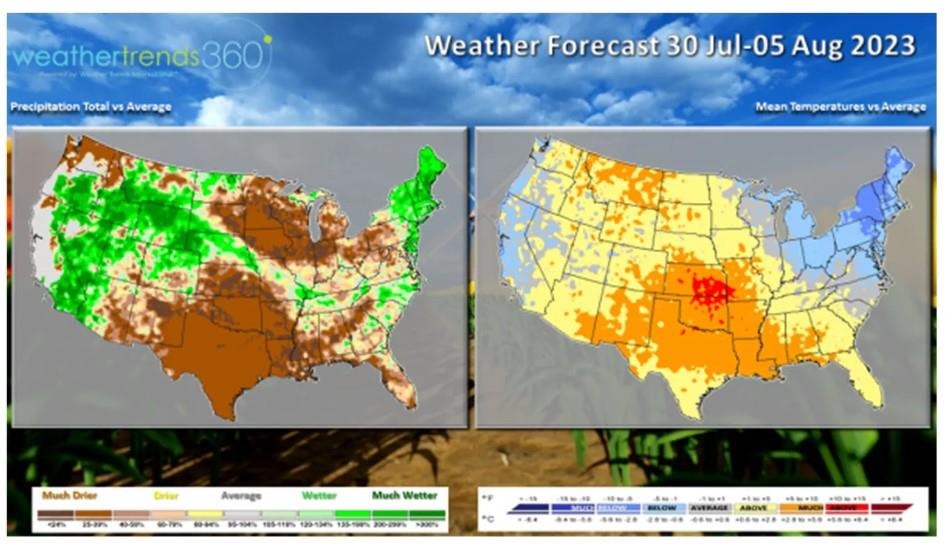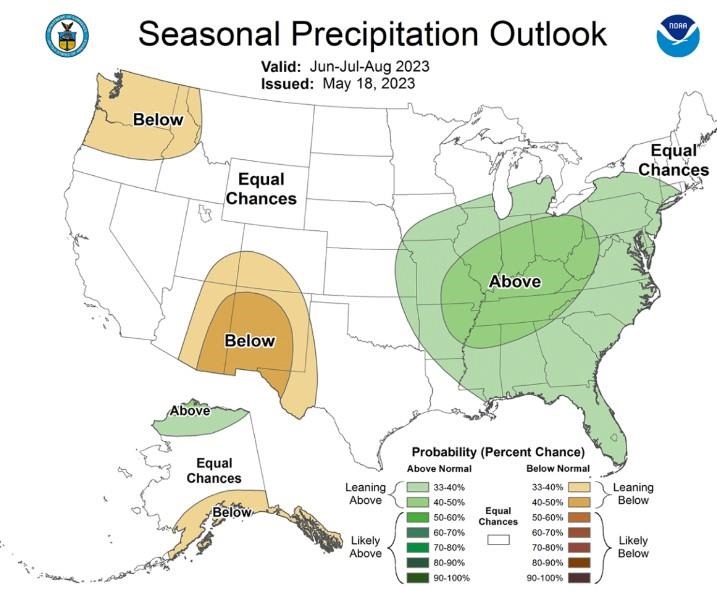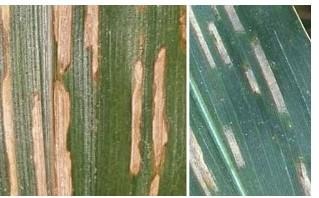By Adam Russell
The shrinking Texas cattle herd is likely to translate into higher calf and beef prices years beyond a break in the 2022 drought, according to a Texas A&M AgriLife Extension Service expert.

Cattle receiving supplemental feed at the Diamond K Ranch in Hempstead, Texas. Many producers have been providing supplemental rations, including hay, grain and cubes all summer due to poor grazing conditions.
David Anderson, Ph.D., AgriLife Extension economist, Bryan-College Station, said Texas cattle producers have culled earlier and deeper than normal this year due to drought. He suspects the number of culls, and the small number of replacement heifers could mean post-drought herd recovery could be longer than the years following record drought in 2011. It could also drive calf prices toward records set in 2014.
“It’s clearly bad out there based on the number of culls we’ve seen,” he said. “Drought is forcing the issue. Whether it is zero grazing, low forage stocks, high feed and hay prices, or running low on water, Texas ranchers are facing tough decisions right now.”
Texas drought shrinking cattle herd
Historically, Texas accounts for a big chunk of the U.S. beef cattle herd. Mother Nature’s impact on Texas ranchers is likely to ripple into sale barns and grocery stores around the country years beyond the drought. The U.S. herd has been shrinking in recent years, and the Texas drought is further reducing cattle numbers.
The U.S. beef cow herd was just over 30 million head in January, down 2% compared to last year, according to the U.S. Department of Agriculture. The total estimated inventory of Texas cows that had calved and heifers was 5.1 million head, down 3% compared to 2020.
Anderson said this weather-related contraction is impacting producers negatively. There are no estimates available that quantify the economic hardship Texas’ ranchers have endured so far in 2022, but livestock losses during the 2011 drought were estimated to be $3.23 billion.
Losses included the increased cost of feeding livestock due to the lack of pastures and ranges and market losses. Market losses included the impact of fewer pounds sold per calf and any impact on market prices due to above-normal cattle sale volumes over a short time.
The 2011 drought was a bad time for ranchers, but the years following included historic cow/calf prices as the Texas and U.S. herd numbers recovered.
Anderson said nominal prices are higher now than in 2011 as the drought was taking hold and forcing widespread herd consolidation and liquidations. The weekly weighted average price for 500-600-pound steers at auctions across Texas in 2011 was $139.73 per hundredweight compared to $181.12 per hundredweight so far this year.
Record prices occurred as the beef cattle herd recovered, and the same weight class steers rose to a weighted average of $236 per hundredweight in 2014. Calf prices peaked in late October 2014 at around $283 per hundredweight.
“The beef cattle market isn’t something that turns on a dime,” he said. “It takes time. Cattle are a long-term cycle, and I suspect this will all play out similarly to the years following the 2011 drought.”
Record low number of replacement heifers
Anderson’s concern about the Texas herd this time compared to 2011 is that replacement heifers – the young, future calf-producing cows – are at their lowest point nationally since USDA began keeping numbers in 1973.

Calf prices could trend upward due to herd contraction from the drought. They hit record levels in 2014 following the 2011 drought.
The number of beef replacement heifers fell to 4.15 million in July, which represents around 13.7% of the national cattle herd, Anderson said. There were more replacement heifers available in 2011, but heifers made up 13.4% of the herd at the time.
“That means we are going to see tight supplies of replacement heifers, and were it to rain and break the drought and pastures recover, we’ll see higher replacement heifer prices,” he said. “The absolute numbers of heifers in 2011 through 2014 are interesting because it indicates a lot of Texas heifers were shipped elsewhere. But this year, we’re already looking at the bottom in terms of estimated numbers.”
Anderson said rainfall spurring winter forages and good spring growth could trigger a reversal, but that a fall and winter with below-average rainfall could make conditions even uglier for Texas cattle producers going into the spring calving season.
Despite the relatively good prices cattle producers are seeing at sale barns now, they are also dealing with much higher input and feed costs compared to a decade ago. Corn and hay prices will continue to weigh on calf prices.
AgriLife Extension beef cattle specialists are warning producers to calculate stockpiled forages, hay rations and potential feed costs against calf sale potential. Feeding cows for extended periods could exceed expected price increases on calves.
“If there is any way to keep young cows and hold on to some replacement heifers, we’re going to see record-high calf prices,” he said. “I think that’s an opportunity, but that’s also easier said than done.”
The 68th annual Texas A&M Beef Cattle Short Course, BCSC, Aug. 1-3 in Bryan-College Station will focus on guiding beef cattle producers through many drought-related management decisions. To register, go to https://beefcattleshortcourse.com/. The cost is $240 for in-person attendance and $160 for online if registered by July 27. A $40 late registration fee will be charged after that date.
AgriLife Extension district reporters compiled the following summaries:

CENTRAL
The district reported no precipitation and record-setting high temperatures. Soil moisture levels were very short and severe drought conditions continued. Pasture conditions were very poor and declining, and stock tanks were dropping with some already dry. Ranchers were reducing livestock numbers due to hay shortages and escalating hay prices. Corn harvest was in full swing with below average yields reported. Few reported corn yields were exceeding 100 bushels per acre, with most acres yielding 50-70 bushels and some yielding below 50 bushels per acre. Sorghum was being harvested as well with decent yields reported. Some specialty crops like double-crop sesame looked surprisingly good. Cotton fields were declining and were developing large areas of chlorosis with patchy necrosis. Crop scouts were actively looking for mites, but no significant infestations were reported so far. At this time, growers typically begin securing winter wheat seed for September/October plantings, but there has been no activity to date.
ROLLING PLAINS
Conditions continued to be extremely hot and dry, but some areas reported improvement following recent rains. Cotton still looked rough with most still not over a foot tall. Sorghum looked fair with some fields starting to head out. The corn crop failed, and some fields were baled as salvage forage. Some sorghum fields were likely to be baled soon. Rangeland and pasture conditions improved some, and tanks received some runoff water. Some farmers cleaned up wheat fields for fall planting. Large numbers of grasshoppers were reported. Large volumes of hay bales were changing hands and prices ranged from $110-$150 for round bales.
COASTAL BEND
Conditions remained extremely hot and dry. Producers harvested corn and grain sorghum and were nearing completion with yields well below average from both crops. Cotton was being defoliated and some was harvested. Rice was nearly all headed out and harvest has begun in areas. Rangeland and pastures continued to decline, and livestock producers were feeding hay to try and extend their grazing. Hay yields were short, bale inventories were low, and prices were higher. There was some baling of grain sorghum and corn stubble. Producers were increasing heavy culling and early weaning as resources were depleted.
EAST
Drought conditions worsened despite a few popup showers. Subsoil and topsoil conditions were very short. Burn bans were implemented across the district. Producers were finding it very difficult to find hay for purchase. Crops, pastures and stock ponds continued to dry up. Pasture and rangeland conditions were very poor to poor. Livestock were in fair condition with supplemental feeding taking place. Producers reported issues with gophers and moles.
SOUTH PLAINS
A small portion of the district received trace amounts up to 1.25 inches of rain. Rain fell hard and created some runoff that helped stock tank levels some. The rain should help pasture conditions. Cotton ranged from nine true leaves with two first position squares to five nodes above white flower. Square set continued to be above 90%. Producers were fertilizing and continuing to water. Only irrigated cotton was squaring, and some dryland farmers were plowing what came up because stands were so sparse. Banks grass mites were seen in grain crops, but not yet at economic threshold. Reports of increased moth pressure turned out to be garden webworms and smartweed borers. Integrated pest management agents indicated little concern for cotton but more for gardeners. Cattle were in good condition.
PANHANDLE
Producers were running pivots hard and fast to help crops survive. Soil moisture levels were very short to short. Triple-digit temperatures were taking a toll. The hot, dry weather continued to reduce pasture, corn and sorghum conditions. Overall crop conditions were poor to fair, and rangeland and pasture conditions were very poor to poor.
NORTH
Topsoil moisture throughout the district was very short. Some counties reported a few sporadic rains but not enough to make a difference to pasture and crop conditions. Cattle were being sold due to a lack of grass and hay. Hay bales were difficult to find, and some soybean fields were baled up as forage. Corn was doing well and close to harvest. Cotton and sunflowers were doing well. Grain sorghum maturity stalled, and many producers were harvesting grain sorghum for livestock forage. No insect or disease pressure was reported. Grasshopper populations were steadily increasing but not causing major damages. Calves were being weaned early, and culls cows were being shipped.
FAR WEST
The average daytime high temperature was 101 degrees with an average nightly low of 80 degrees. Little to no rain was reported. Cotton was beginning to show stress during the heat of the day, and plants were entering growth stages when moisture will be critical for blooms and setting bolls. Irrigated Pima cotton looked excellent and upland fields looked good. Corn was a lost cause, and most growers were debating whether to harvest fields due to low yield potential. Melon harvest continued and was the one bright spot for producers as demand continued to be good. Pecan loads were good in the Rio Grande Valley for the most part, and some orchards were expecting excellent yields. The El Paso County Water Improvement District was expected to announce soon when irrigation would be shut off for the remainder of the year. Producers were reporting Mozena obtusa, mesquite webworm and rose rosette. Producers continued to cull and sell livestock.
WEST CENTRAL
The district was very hot and very dry with temperatures above 100 degrees daily. Dryland cotton was being zeroed out through insurance, and irrigated cotton that remained was in poor to fair condition as producers struggled to keep up with water demands. Very little hay was being produced from irrigated pastures. Corn was mature and drying down, and harvest should start soon with below-average yields expected. Harvested acres were expected to be limited as many corn acres went to silage due to irrigation limits early in the season. Irrigated sorghum was fair, but yields were expected to be down. Trees of all species were dropping leaves early. Insect pest problems were increasing. Livestock producers were thinning herds and liquidating stock.
SOUTHWEST
Conditions continued to deteriorate due to extreme heat and drought. Most rangeland grasses and certain water-intensive deciduous plants continued to go into dormancy due to lack of moisture. Corn and milo harvest continued with well-below average yields reported. Rangelands continued to be extremely dry with elevated fire danger. Cotton fared well in the hot conditions but was being heavily irrigated. Herd numbers were still being culled. Livestock were still being supplemented and many were being sold because of drought. Rivers and tanks were drying up.
SOUTH
Soil moisture conditions were very short to short across the district with triple-digit temperatures reported. High daytime temperatures reached 110 degrees with no rainfall reported. Irrigated crops looked fair. Corn harvest continued. Cotton was still in the blooming stage in some areas, and harvest was underway in others. Many cotton acres continued to struggle and might not be harvested. Producers also started harvesting sesame fields. Most early planted grain corn and sorghum was harvested with poor yields reported. Peanuts were pegging. Citrus and sugarcane continued to be irrigated. Water levels in Falcon Lake were very low. Rangeland and pasture conditions continued to decline, and supplemental feeding for cattle continued. Hay harvests were well below normal, and supplies were tightening leading to rising bale prices. Deliveries of hay were increasing. Cattle producers were thinning or liquidating herds. Sale barns were reporting lower prices on cattle with fair to poor body condition scores. Sunflower and sorghum food plots were in poor condition. Wildlife, including deer, were being provided supplemental feed, and fawn sightings were reported. Feed prices continued to be high.
Source : tamu.edu